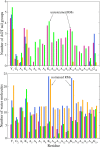Role of Charge and Solvation in the Structure and Dynamics of Alanine-Rich Peptide AKA2 in AOT Reverse Micelles
- PMID: 25337983
- PMCID: PMC4516319
- DOI: 10.1021/jp508813n
Role of Charge and Solvation in the Structure and Dynamics of Alanine-Rich Peptide AKA2 in AOT Reverse Micelles
Abstract
The propensity of peptides to form α-helices has been intensely studied using theory, computation, and experiment. Important model peptides for the study of the coil-to-helix transition have been alanine-lysine (AKA) peptides in which the lysine residues are placed on opposite sides of the helix avoiding charge repulsion while enhancing solubility. In this study, the effects of capped versus zwitterionic peptide termini on the secondary structure of alanine-rich peptides in reverse micelles are explored. The reverse micelles are found to undergo substantial shape fluctuations, a property observed in previous studies of AOT reverse micelles in the absence of solvated peptide. The peptides are observed to interact with water, as well as the AOT surfactant, including interactions between the nonpolar residues and the aliphatic surfactant tails. Computation of IR spectra for the amide I band of the peptide allows for direct comparison with experimental spectra. The results demonstrate that capped AKA2 peptides form more stable α helices than zwitterionic AKA2 peptides in reverse micelles. The rotational anisotropy decay of water is found to be distinctly different in the presence or absence of peptide within the reverse micelle, suggesting that the introduction of peptide significantly alters the number of free waters within the reverse micelle nanopool. However, neither the nature of the peptide termini (capped or charged) nor the degree of peptide helicity is found to significantly alter the balance of interactions between the peptides and the environment. Observed changes in the degree of helicity in AKA2 peptides in bulk solution and in reverse micelle environments result from changes in peptide confinement and hydration as well as direct nonpolar and polar interactions with the water-surfactant interface.
Figures










Similar articles
-
Exploring the role of hydration and confinement in the aggregation of amyloidogenic peptides Aβ(16-22) and Sup35(7-13) in AOT reverse micelles.J Chem Phys. 2014 Dec 14;141(22):22D530. doi: 10.1063/1.4902550. J Chem Phys. 2014. PMID: 25494801 Free PMC article.
-
Protein folding in a reverse micelle environment: the role of confinement and dehydration.J Chem Phys. 2011 Feb 7;134(5):055107. doi: 10.1063/1.3545982. J Chem Phys. 2011. PMID: 21303167 Free PMC article.
-
Structure, stability, and hydration of a polypeptide in AOT reverse micelles.J Am Chem Soc. 2006 Jan 18;128(2):382-3. doi: 10.1021/ja053043u. J Am Chem Soc. 2006. PMID: 16402804
-
Probing the structure and dynamics of confined water in AOT reverse micelles.J Phys Chem B. 2013 Jun 20;117(24):7345-51. doi: 10.1021/jp402270e. Epub 2013 Jun 6. J Phys Chem B. 2013. PMID: 23687916 Free PMC article.
-
Geometry and nanolength scales versus interface interactions: water dynamics in AOT lamellar structures and reverse micelles.J Am Chem Soc. 2009 Jun 17;131(23):8318-28. doi: 10.1021/ja901950b. J Am Chem Soc. 2009. PMID: 19449867
Cited by
-
Biomolecular Crowding Arising from Small Molecules, Molecular Constraints, Surface Packing, and Nano-Confinement.J Phys Chem Lett. 2015 Jul 2;6(13):2546-53. doi: 10.1021/acs.jpclett.5b00957. Epub 2015 Jun 18. J Phys Chem Lett. 2015. PMID: 26266732 Free PMC article.
-
Exploring the role of hydration and confinement in the aggregation of amyloidogenic peptides Aβ(16-22) and Sup35(7-13) in AOT reverse micelles.J Chem Phys. 2014 Dec 14;141(22):22D530. doi: 10.1063/1.4902550. J Chem Phys. 2014. PMID: 25494801 Free PMC article.
References
Publication types
MeSH terms
Substances
Grants and funding
LinkOut - more resources
Full Text Sources
Other Literature Sources

